Issue #92: (Not) Putting the “i” in Pimento Cheese
A Southern Spread for the Birthday Boy, Orthographic Anomalies, Going Crackers, Conway Twitty's Death, and My Recipe for Pimento Cheese
A week of good cooking and eating has restored my internal balance. In addition to all the usual meals, for Purim this week I made the triple chocolate hamantaschen from The Jewish Table newsletter by Leah Koenig. I highly recommend the cookies and Leah’s newsletter. —Mitchell
Nate’s birthday was last weekend, and as is usually the case if we aren’t traveling or going out to dinner somewhere fancy, I cooked a traditional southern meal of his favorite foods: fried chicken, macaroni and cheese, biscuits, honey-glazed carrots, and Brussels sprouts with bacon. Some years I add cornbread and/or potato salad. Nate was raised in Alabama, after all.
At first, I wasn’t sure what to serve as an hors d’oeuvre. For a moment I considered the heft of the meal to come and thought I wouldn’t serve anything to start. But Nate likes his Champagne and I thought we’d need something to help slow the absorption of alcohol into the blood stream if he were to stay awake until dessert. Aha! Pimento cheese! Also, one of his favorite things. And something I hadn’t made in a while.
Pimento cheese was a favorite of Nate’s mom’s, always store bought, of course. She typically ate it on Waverly crackers, a type of cracker I wasn’t familiar with, but turns out to be similar to what I know as “Club.” I looked for recipes to simulate the crackers, too, while I was at it. Together, pimento cheese and homemade club crackers would be the perfect, culturally appropriate start to his birthday celebration.
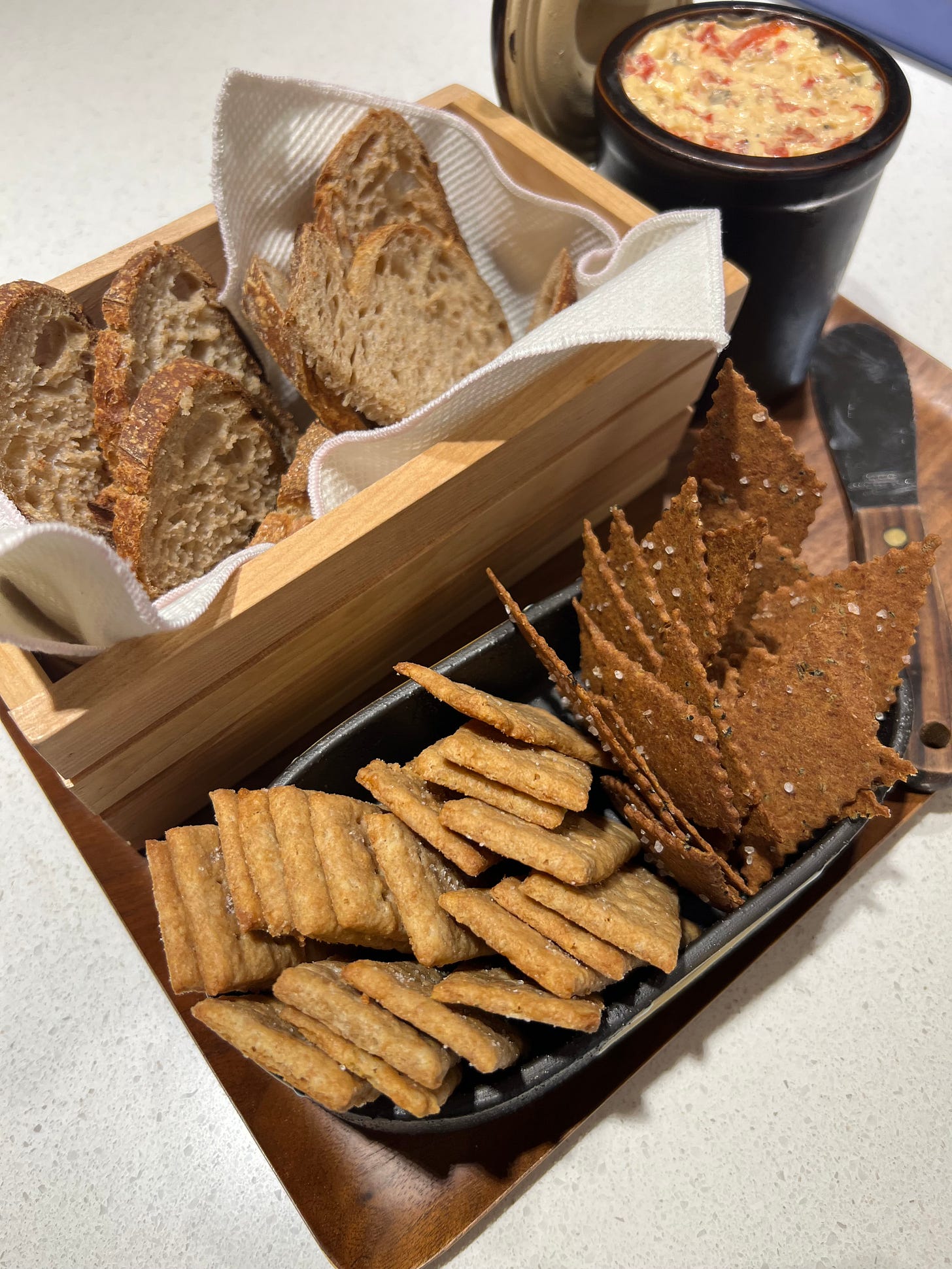
The pimento cheese I’ve been making for years is based on a recipe by southern chef Sean Brock that I stumbled across in his cookbook, Heritage. Brock’s recipe is pretty traditional, calling for Duke’s mayonnaise, tabasco, and sharp cheddar. I appreciated his addition of pickled ramps, which is something I put up every spring, and which, when I was making pimento cheese more regularly, I began to can in ¼ pint jars, the perfect size for one batch of pimento cheese. Luckily, I still had one jar left in the cupboard. If you don’t have pickled ramps, you can used pickled anything, really, such as bread and butter pickles (see Issue #85) or relish. A sweet-brined pickle adds a traditional amount of acidity and sweetness, but really any pickle will work.
Brock also suggests roasting your own pimento peppers, which I’ve never seen fresh in the market. If I find them roasted and peeled in cans or jars, I buy them to have on hand. (A 7-ounce jar is enough for a batch of pimento cheese.) You can even buy them already chopped. Otherwise, just roast your own red bell pepper and use some sweet pickle brine to enhance the flavor, which is what I did this weekend. The fanciest, sweetest, most flavorful pimentos from Spain are denominated “Pimientos del Piquillo de Losada.” These can be very pricey and are probably too fine to use in a cheese spread like this (same with cloth-bound cheddar, see below). Serve piquillo peppers on their own, dressed with a little olive oil, vinegar, and garlic.
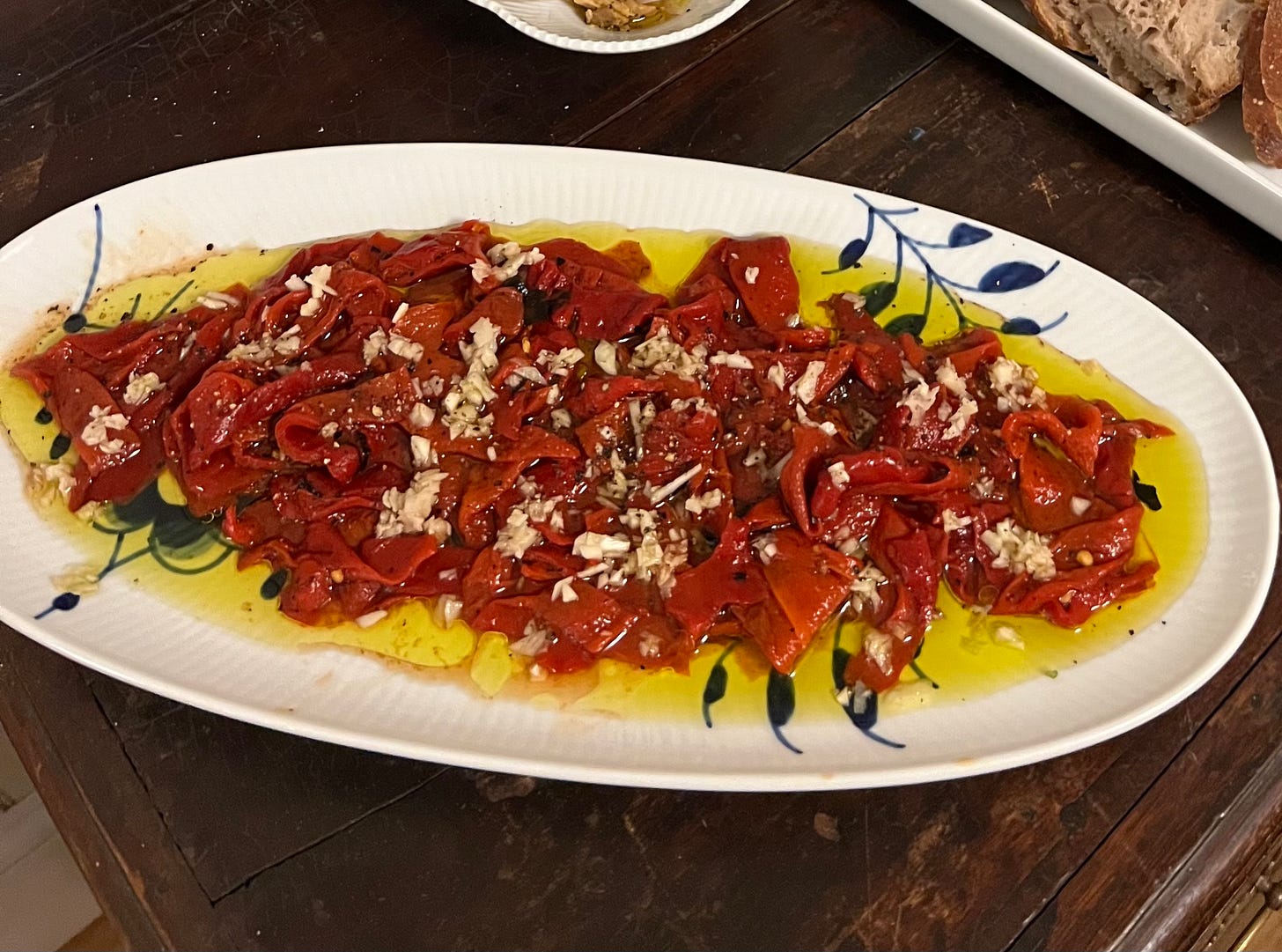
Peppering Your Spelling with Extra Vowels
You’ll note above that the fancy Spanish peppers are designated “pimientos.” I grew up thinking my sister’s love for pimiento-stuffed olives was a familial affectation, but it turns out both pimento and pimiento are correct in English. The latter is technically Spanish. But if you look closely, most authorities on southern cooking, including Southern Living magazine, and the labels of most commercial pepper products, favor “pimiento.” In my mind, I can rationalize why one might want to refer to the peppers, which often come from Spain and/or are marketed to a Spanish-speaking audience, as “pimiento.” But to call pimento cheese, one of the most American of American dishes, “pimiento cheese,” just seems pretentious to me. And to use one spelling for peppers and another for cheese spread is a style editor’s nightmare that would register as a typo to most readers. So, I’m just using pimento for both now. In future issues, perhaps, we will explore aluminum/aluminium foil and Parmigiano/parmesan cheese.
Though it is most traditional to use Duke’s mayonnaise for pimento cheese, as chef Brock suggests, I use my own homemade mayo (see Issue #6). If you can’t find Duke’s where you are and you don’t want to bother with homemade, Hellmann’s or Best Foods is fine, too. Along with the mayo, cream cheese helps bind things together, but I occasionally use some fresh goat cheese to keep everything local and artisanal.
For the grated cheese, I like to use a combination of sharp and less-sharp cheddars, which adds some variability of flavor and texture. Some Colby or Monterey Jack is good, too. I buy reasonably priced blocks of raw-milk cheddar from an Amish dairy in the Union Square Greenmarket, but you can use any ordinary cheese from the grocery store, too—it would be more traditional, in fact. As with the fancy Spanish peppers, I wouldn’t waste a cloth-bound cheddar on something like pimento cheese, as the nuances of flavor will be lost in combination with all the other ingredients. (Were we making “pimiento cheese,” I might feel different.)
Did Pimento Cheese Kill Conway Twitty?
My recipe makes about three cups of pimento cheese, which is a lot. More than you need for hors d’oeuvres for a small dinner party. One nice thing about making too much pimento cheese is that you can use it as an ingredient in many things. I stirred some into the mac’n’cheese I made for Nate’s birthday, of course, but then the next day I also stirred some into scrambled eggs for breakfast. It’s really versatile. You can also just eat it off a spoon.
Thinking about too much pimento cheese brings to mind a related story. Nate’s best friend Merritt from high school lives in Nashville and is married to a fine chap named Tom Bailey. During high school in Nashville, Tom worked as a caterer/counterperson at a popular lunch spot, where he was responsible for preparing their beloved pimento cheese. The singer Conway Twitty was a fan, and came in daily for a dose. Upon embarking on a tour in 1993, Twitty stopped into the shop and purchased six pounds of Tom’s pimento cheese for the road. A few days later he fell ill on the tour and died. Was it the too much pimento cheese Tom has wondered ever since?
Years later, Tom parlayed his pimento cheese know-how into a successful business called Professor Bailey’s Pimento Cheese (note the spelling), which sells his popular cheese spread in three degrees of spiciness, as well as frozen, ready-to-bake pimento cheese biscuits and gougères, all very fine, indeed. So, if you’d rather not bother with making your own, stop reading now and click on this link to order some Professor Bailey’s today.
RECIPE: Pimento Cheese
(Makes about 3 cups)
1 large, fresh red bell pepper (about 10 ounces) for roasting, otherwise, one 7-ounce jar roasted pimento peppers, drained, or 1 or 2 roasted red peppers, peeled and seeded
½ cup (4 ounces) cream cheese or soft, fresh goat cheese, at room temperature
1/3 cup mayonnaise, preferably homemade (see here), Duke’s, Hellmann’s or Best Foods
½ teaspoon Tabasco
½ teaspoon kosher salt
¼ teaspoon paprika, Hungarian or Spanish, sweet or smoked
1/8 teaspoon chili powder, fragrant but not too hot, such as cayenne, Kashmiri, chipotle, or a favorite
Freshly ground white or black pepper
¼ cup chopped pickled ramps, bread and butter pickles, dill pickles, or pickle relish, plus a tablespoon or two of brine
½ pound sharp cheddar cheese, grated (about 2 cups)
½ pound mild cheddar, Colby or Monterey Jack cheese, grated (about 2 cups)
If using a fresh red bell pepper, set it directly over a gas burner turned too high and let roast, turning frequently with tongs, until almost completely black. Alternately, you can roast over a hot charcoal or gas grill, or in a pan in a 475°F. oven. Once blackened, transfer to a small bowl, cover tightly with a lid or plastic wrap, and let cool to room temperature. Using your fingertips, remove the blackened skin. Do not rinse the pepper under water, which washes away flavor. Instead, rinse the pieces of blackened skin off your hands as you work. When peeled, use a small, sharp knife to remove the stem. Cut the pepper open, remove the seeds and the ribs. Whichever form of pepper you are using, cut it into 1/8-inch dice.
In a medium bowl, use a wooden spoon to blend the cream cheese or goat cheese until soft. Add the mayonnaise and continue blending until combined. Add the diced roasted pepper along with all of the remaining ingredients—Tabasco, salt, paprika, chili powder, a generous amount of freshly ground white or black pepper, pickled ramps or other pickles, a tablespoon for two of pickle brine, and the sharp and mild cheese—and stir to combine well. Taste and adjust the seasoning.
The pimento cheese can be eaten right away but it is best if left to sit overnight in the refrigerator so the flavors have a chance to meld. It will keep a week or more in the fridge. It can also be frozen, though the texture changes a little. Beat it together again or use it to cook.
Serve the pimento cheese with bread or your favorite crackers. I like our house sourdough crackers (see Issue #16). And as I said above, for authenticity’s sake I made homemade Waverly or Club crackers for Nate’s birthday using this recipe, which calls for einkorn flour. I made two adjustments to the recipe, increasing the salt in the dough to 3/4 teaspoon and, once they were baked, brushed with butter, and sprinkled with more fine salt, returning the crackers to the turned-off oven for 20 to 30 minutes, or so, to crisp up in the residual heat. (If your oven holds too much or too little residual heat, you can set a countertop oven to 125°F. and crisp them in there for 30 minutes or so.)
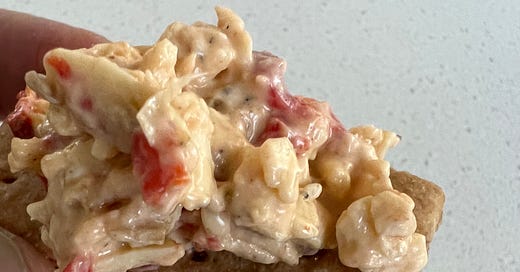


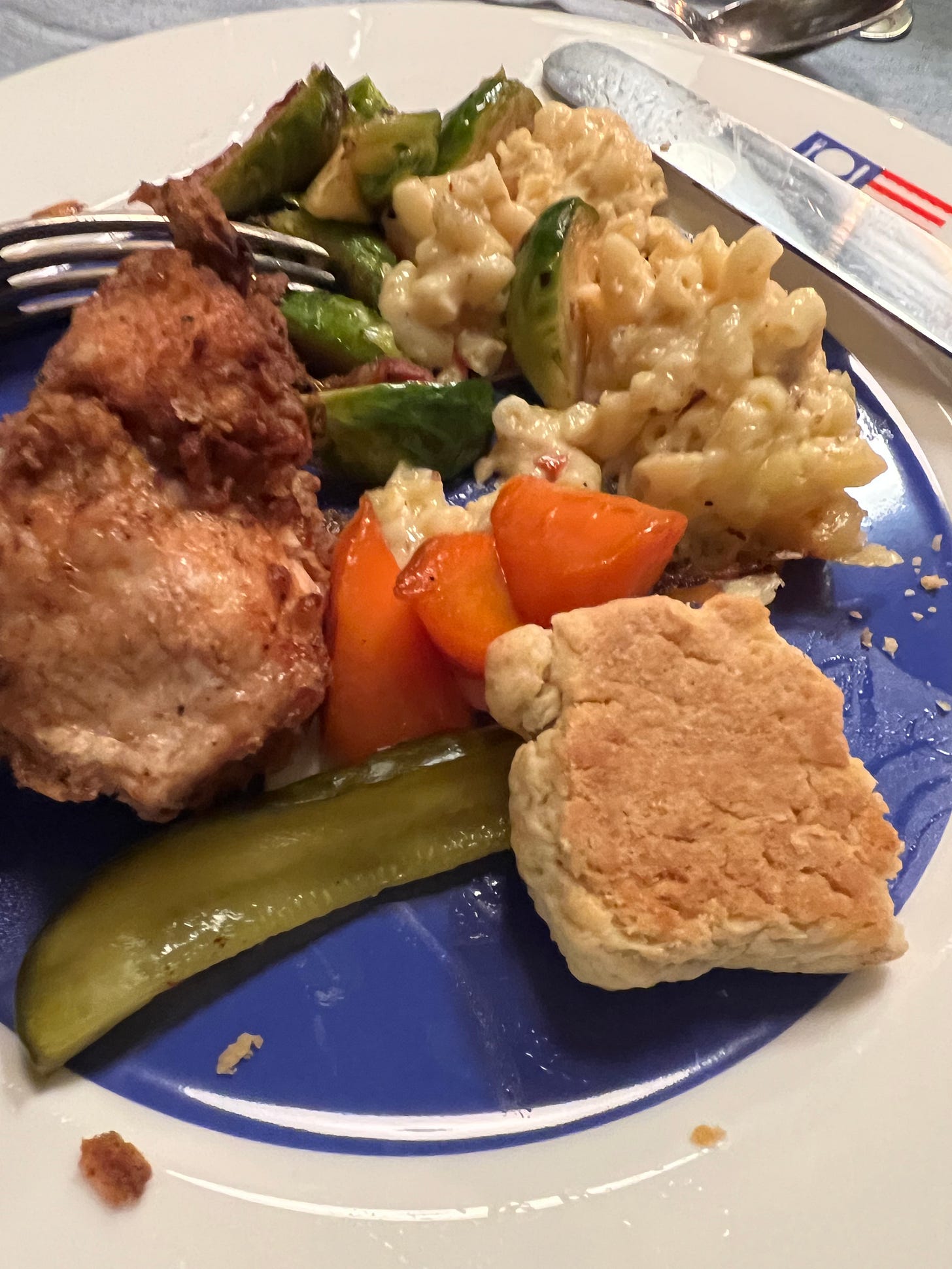
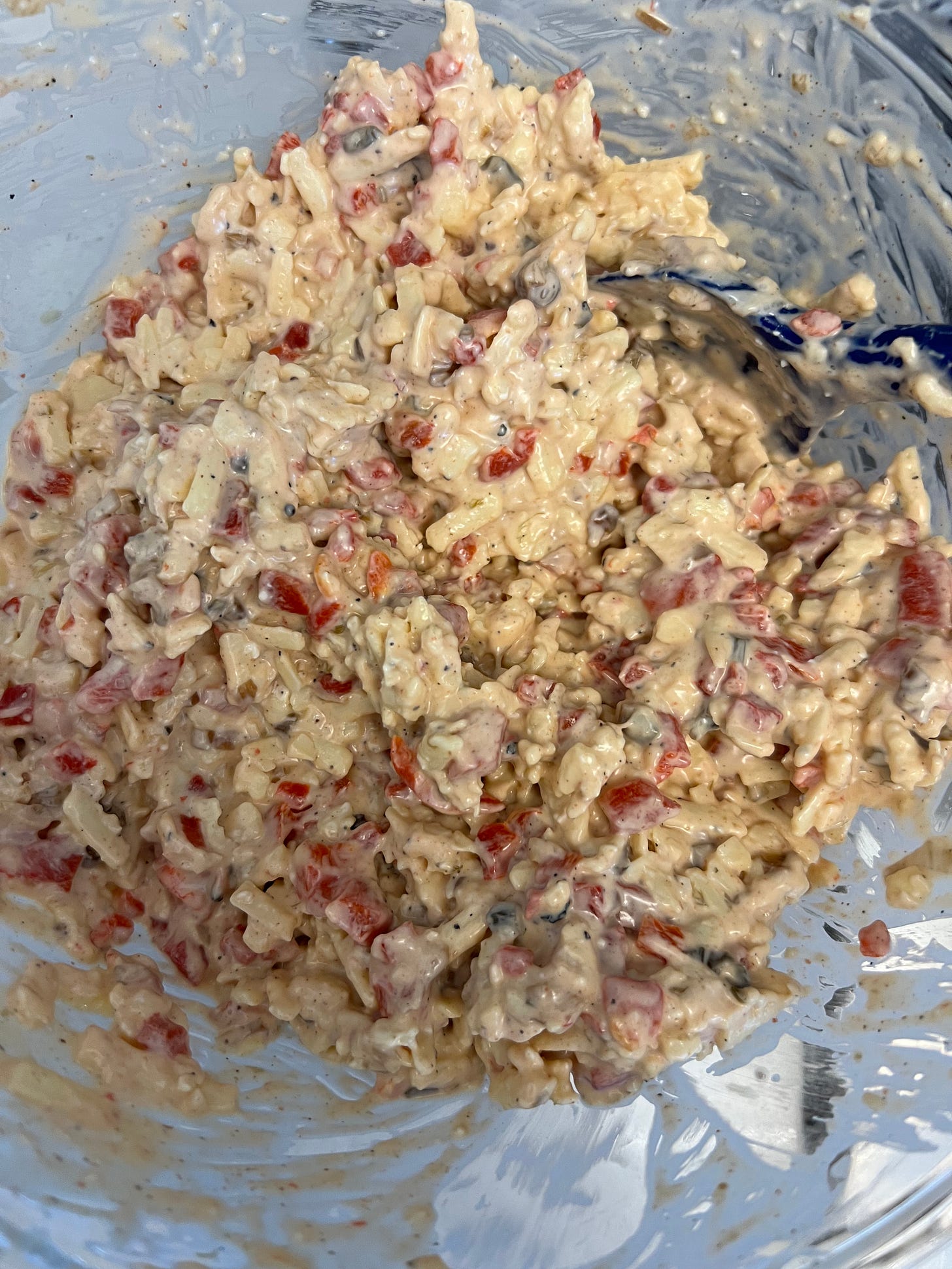


If Nate loves Southern food run, don't walk, to this new tiny restaurant with huge food called KJUN at 154 E. 39th St. The chef combines flavors from her native Korea with tastes of New Orleans from her years there, and everything is spectacular, from the shrimp and fried oyster Po' Boy to the honeyed potato chips, corn bread, fried chicken, Southern pancake with pecans for dessert and more. We went mid-afternoon and got right in, for dinners a reservation would be good.
The old time pronunciation I hear the most around Nashville is "pah-MIN-uh cheese." Louis Osteen always called it redneck pate. This recipe rounds delicious! Mitchell--while you're snacking I hope you'll listen to to a little Conway Twitty. His music is epic.